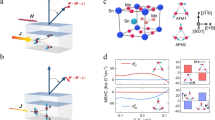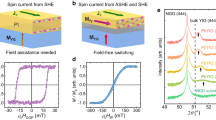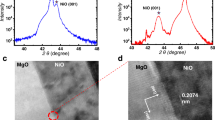Abstract
The development of spintronic devices based on spin–orbit torque requires the electrical-current-driven field-free switching of magnetization in materials with perpendicular magnetic anisotropy. However, approaches to achieve such switching typically require additional magnetic layers or structural engineering, which complicates fabrication processes and impedes the scalability and stability of devices. Here we report the field-free switching of the perpendicular magnetic anisotropy ferromagnet cobalt iron boron at room temperature using out-of-plane spin-polarized current generated by the Weyl semimetal tantalum iridium telluride (TaIrTe4). Bilinear magnetoelectric resistance and spin-torque ferromagnetic resonance measurements confirm the out-of-plane polarized spins, and the out-of-plane spin canting angle is estimated to be around 8°. The spin Hall conductivity of TaIrTe4 is estimated to be 5.44 × 104 × ћ/2e (Ω m)−1, which is almost one order of magnitude larger than that of tungsten ditelluride. Our results indicate that TaIrTe4 is an efficient spin current source for field-free spin–orbit torque applications.
This is a preview of subscription content, access via your institution
Access options
Access Nature and 54 other Nature Portfolio journals
Get Nature+, our best-value online-access subscription
$29.99 / 30 days
cancel any time
Subscribe to this journal
Receive 12 digital issues and online access to articles
$119.00 per year
only $9.92 per issue
Buy this article
- Purchase on Springer Link
- Instant access to full article PDF
Prices may be subject to local taxes which are calculated during checkout




Similar content being viewed by others
Data availability
The data that support the plots within this paper and other findings of this study are available from the corresponding author upon reasonable request.
Code availability
The codes that support this study are available from the corresponding author upon reasonable request.
References
Miron, I. M. et al. Perpendicular switching of a single ferromagnetic layer induced by in-plane current injection. Nature 476, 189–193 (2011).
Liu, L. et al. Spin-torque switching with the giant spin Hall effect of tantalum. Science 336, 555–558 (2012).
Shao, Q. et al. Roadmap of spin-orbit torques. IEEE Trans. Magn. 57, 800439 (2021).
Liu, L., Lee, O. J., Gudmundsen, T. J., Ralph, D. C. & Buhrman, R. A. Current-induced switching of perpendicularly magnetized magnetic layers using spin torque from the spin Hall effect. Phys. Rev. Lett. 109, 096602 (2012).
Lau, Y.-C., Betto, D., Rode, K., Coey, J. M. D. & Stamenov, P. Spin-orbit torque switching without an external field using interlayer exchange coupling. Nat. Nanotechnol. 11, 758–762 (2016).
Oh, Y.-W. et al. Field-free switching of perpendicular magnetization through spin-orbit torque in antiferromagnet/ferromagnet/oxide structures. Nat. Nanotechnol. 11, 878–884 (2016).
Fukami, S., Zhang, C., DuttaGupta, S., Kurenkov, A. & Ohno, H. Magnetization switching by spin-orbit torque in an antiferromagnet-ferromagnet bilayer system. Nat. Mater. 15, 535–541 (2016).
van den Brink, A. et al. Field-free magnetization reversal by spin-Hall effect and exchange bias. Nat. Commun. 7, 10854 (2016).
Yu, G. et al. Switching of perpendicular magnetization by spin-orbit torques in the absence of external magnetic fields. Nat. Nanotechnol. 9, 548–554 (2014).
Safeer, C. K. et al. Spin-orbit torque magnetization switching controlled by geometry. Nat. Nanotechnol. 11, 143–146 (2016).
Liu, L. et al. Current-induced magnetization switching in all-oxide heterostructures. Nat. Nanotechnol. 14, 939–944 (2019).
Kong, W. J. et al. Spin–orbit torque switching in a T-type magnetic configuration with current orthogonal to easy axes. Nat. Commun. 10, 233 (2019).
Manchon, A. et al. Current-induced spin-orbit torques in ferromagnetic and antiferromagnetic systems. Rev. Mod. Phys. 91, 035004 (2019).
Ramaswamy, R., Lee, J. M., Cai, K. & Yang, H. Recent advances in spin-orbit torques: moving towards device applications. Appl. Phys. Rev. 5, 031107 (2018).
MacNeill, D. et al. Control of spin-orbit torques through crystal symmetry in WTe2/ferromagnet bilayers. Nat. Phys. 13, 300–305 (2017).
Macneill, D. et al. Thickness dependence of spin-orbit torques generated by WTe2. Phys. Rev. B 96, 054450 (2017).
Baek, S. C. et al. Spin currents and spin–orbit torques in ferromagnetic trilayers. Nat. Mater. 17, 509–513 (2018).
Shi, S. et al. All-electric magnetization switching and Dzyaloshinskii-Moriya interaction in WTe2/ferromagnet heterostructures. Nat. Nanotechnol. 14, 945–949 (2019).
Shi, S. et al. Observation of the out-of-plane polarized spin current from CVD grown WTe2. Adv. Quantum Technol. 4, 2100038 (2021).
Liu, L. et al. Symmetry-dependent field-free switching of perpendicular magnetization. Nat. Nanotechnol. 16, 277–282 (2021).
Chen, X. et al. Observation of the antiferromagnetic spin Hall effect. Nat. Mater. 20, 800–804 (2021).
Kao, I.-H. et al. Deterministic switching of a perpendicularly polarized magnet using unconventional spin-orbit torques in WTe2. Nat. Mater. 21, 1029–1034 (2022).
Hu, S. et al. Efficient field-free perpendicular magnetization switching by a magnetic spin Hall effect. Nat. Commun. 13, 4447 (2022).
Zhao, B. et al. Unconventional charge-spin conversion in Weyl-semimetal WTe2. Adv. Mater. 32, 2000818 (2020).
Zhao, B. et al. Observation of charge to spin conversion in Weyl semimetal WTe2 at room temperature. Phys. Rev. Research 2, 013286 (2020).
Xie, Q. et al. Field-free magnetization switching induced by the unconventional spin-orbit torque from WTe2. APL Mater. 9, 051114 (2021).
Liu, L., Moriyama, T., Ralph, D. C. & Buhrman, R. A. Spin-torque ferromagnetic resonance induced by the spin Hall effect. Phys. Rev. Lett. 106, 036601 (2011).
Wang, Y., Deorani, P., Qiu, X., Kwon, J. H. & Yang, H. Determination of intrinsic spin Hall angle in Pt. Appl. Phys. Lett. 105, 152412 (2014).
Koepernik, K. et al. TaIrTe4: a ternary type-II Weyl semimetal. Phys. Rev. B 93, 201101(R) (2016).
He, P. et al. Bilinear magnetoelectric resistance as a probe of three-dimensional spin texture in topological surface states. Nat. Phys. 14, 495–499 (2018).
Liu, Y. et al. Raman signatures of broken inversion symmetry and in-plane anisotropy in type-II Weyl semimetal candidate TaIrTe4. Adv. Mater. 30, 1706402 (2018).
Kumar, D. et al. Room-temperature nonlinear Hall effect and wireless radiofrequency rectification in Weyl semimetal TaIrTe4. Nat. Nanotechnol. 16, 421–425 (2021).
Guimarães, M. H. D., Stiehl, G. M., MacNeill, D., Reynolds, N. D. & Ralph, D. C. Spin-orbit torques in NbSe2/permalloy bilayers. Nano Lett. 18, 1311–1316 (2018).
Safeer, C. K. et al. Room-temperature spin Hall effect in graphene van der Waals heterostructures. Nano Lett. 19, 1074–1082 (2019).
Liang, S. et al. Spin-orbit torque magnetization switching in MoTe2/permalloy heterostructures. Adv. Mater. 32, 2002799 (2020).
Stiehl, G. M. et al. Layer-dependent spin-orbit torques generated by the centrosymmetric transition metal dichalcogenide β-MoTe2. Phys. Rev. B 100, 184402 (2019).
Han, J. et al. Room-temperature spin-orbit torque switching induced by a topological insulator. Phys. Rev. Lett. 119, 077702 (2017).
Wang, Y. et al. Room temperature magnetization switching in topological insulator-ferromagnet heterostructures by spin-orbit torques. Nat. Commun. 8, 1364 (2017).
Xu, H. et al. High spin Hall conductivity in large-area type-II Dirac semimetal PtTe2. Adv. Mater. 32, 2000513 (2020).
Pai, C.-F., Mann, M., Tan, A. J. & Beach, G. S. Determination of spin torque efficiencies in heterostructures with perpendicular magnetic anisotropy. Phys. Rev. B 93, 144409 (2016).
Vansteenkiste, A. et al. The design and verification of MuMax3. AIP Adv. 4, 107133 (2014).
Iihama, S. et al. Gilbert damping constants of Ta/CoFeB/MgO(Ta) thin films measured by optical detection of precessional magnetization dynamics. Phys. Rev. B 89, 174416 (2014).
Acknowledgements
This work was supported by SpOT-LITE program (A*STAR grant, A18A6b0057) through RIE2020 funds; Samsung Electronics (IO221024-03172-01); National Natural Science Foundation of China (nos. 22175203 and 22006023); Natural Science Foundation of Guangdong Province (nos. 2022B1515020065 and 2019A1515010428); and Plan Fostering Project of the State Key Laboratory of Optoelectronic Materials and Technologies, Sun Yat-sen University (no. OEMT-2021-PZ-02). We would like to acknowledge that the simulation work involved in this research is partially supported by NUS Information Technology’s High Performance Computing.
Author information
Authors and Affiliations
Contributions
Y.L., D.K. and H.Y. designed the experiment. Y.L. fabricated the devices and analysed the data with the help of G.S., D.K. and F.W. Y.L. performed the BMR and switching measurements. G.S. and S.S. performed the ST-FMR measurement. T.K., Y.L., G.S. and K.C. performed the simulations. D.Y. performed the Raman measurements. C.Z. and Y.P. helped in the device fabrication for rebuttal. S.Y. deposited the PMA layer. J.Z. and P.Y. provided the single crystals of TaIrTe4. All authors discussed the results and commented on the manuscript. Y.L., G.S., T.K., D.K. and H.Y. wrote the manuscript. H.Y. initiated the idea and led the project.
Corresponding author
Ethics declarations
Competing interests
The authors declare no competing interests.
Peer review
Peer review information
Nature Electronics thanks Saroj Dash, Hai-Zhou Lu and the other, anonymous, reviewer(s) for their contribution to the peer review of this work.
Additional information
Publisher’s note Springer Nature remains neutral with regard to jurisdictional claims in published maps and institutional affiliations.
Supplementary information
Supplementary Information
Supplementary Notes 1–15, Figs. 1–19 and Table 1.
Rights and permissions
Springer Nature or its licensor (e.g. a society or other partner) holds exclusive rights to this article under a publishing agreement with the author(s) or other rightsholder(s); author self-archiving of the accepted manuscript version of this article is solely governed by the terms of such publishing agreement and applicable law.
About this article
Cite this article
Liu, Y., Shi, G., Kumar, D. et al. Field-free switching of perpendicular magnetization at room temperature using out-of-plane spins from TaIrTe4. Nat Electron 6, 732–738 (2023). https://doi.org/10.1038/s41928-023-01039-2
Received:
Accepted:
Published:
Issue Date:
DOI: https://doi.org/10.1038/s41928-023-01039-2
This article is cited by
-
Highly efficient field-free switching of perpendicular yttrium iron garnet with collinear spin current
Nature Communications (2024)



